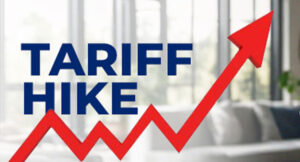As the United States (US) imposes reciprocal tariffs on India, expanding the production-linked incentive (PLI) scheme may be key to upholding the ambitious ‘Make in India’ initiative and mitigating the potential trade impact, say experts.
US President Donald Trump has announced reciprocal tariffs of 27 per cent on imports from India effective April 9.
However, certain goods – pharmaceutical products, semiconductors, lumber articles, copper and gold, energy resources and select minerals – have been spared the rod. Moreover, steel, aluminium, automobiles, and auto components are already covered under Section 232 duties.
Economists feel that the latest tariffs announced by the Trump administration could compel India to go faster on reforms and push the pedal further on its programmes such as ‘Make in India’ and the PLI scheme.
The PLI scheme was launched in 2020 to position India as a global manufacturing hub. With an outlay of Rs 1.97 trillion, it covers 14 sectors including mobile phone, drone, white goods, telecommunications, textiles, automotive, specialty steel, pharmaceutical drugs.
Madan Sabnavis, chief economist, Bank of Baroda, believes that the government would have to push the schemes and provide protection to domestic industries. “The sectors impacted by the reciprocal tariffs are textile, precious stones and to a small extent pharma which involve small and medium enterprises. There could be a bigger push for PLI in these sectors.”
Tempering the impact
The PLI scheme may also help cushion the blow for some sectors. For instance, India’s electronics exports, seeing a major boom driven by the shift of Apple’s iPhone manufacturing in India, is expected to be impacted. But experts noted that the sector may be better placed due to the PLI scheme for smartphones.
“Though electronics exports are directly hit by the US reciprocal tariffs, it is still better positioned to withstand the impact when compared to its Asian competitors like China and Vietnam. Also, India’s export competitiveness may remain relatively less affected due to its smaller share in the global electronics supply chain compared to its rivals, coupled with nascent but growing manufacturing under the PLI scheme, are expected to cushion immediate impacts,” said Kunal Chaudhary, Tax Partner, EY India.
At present, India is contributing 10-15 per cent of iPhone production. On the other hand, for China, the new tariff rate is around 54 per cent, and for Vietnam, 46 per cent.
Giving a fillip
In certain segments, like textiles, India stands in better stead with respect to competitors like Vietnam, Bangladesh and China, which face higher tariffs.
However, Naren Goenka from Texport Industries says India’s textile industry may also need more support from the government to further boost ‘Make in India’ to meet a possible rising demand.
The electric vehicle sector has a good opportunity to capture a larger share of the US market, especially in the budget car segment, according to EY India. China’s auto and component exports to the US stood at $17.99 billion, while India’s was only $2.1 billion last year.
It added, “To accelerate this, the government should enhance the PLI scheme by including more auto components, opening it to new players, and extending it by two years.”
Saurabh Agarwal, Tax partner, EY India said that to fully leverage India’s export potential, the government should expand existing PLI schemes in the sector to cover a wider range of products.
Concerns galore
Experts feel that India’s growth which is largely dependent on domestic demand is not likely to be hugely impacted. CareEdge estimates that the direct impact of reciprocal tariffs on India’s GDP would be 0.2 to 0.3 per cent.
“The government, however, has to ensure that the domestic consumption and demand remain healthy. To do that, it is important to push manufacturing activity and job creation,” said Rajani Sinha, chief economist, CareEdge.
While the impact of reciprocal tariffs on global growth is yet to be assessed, economy experts say that its impact on India will be limited, compared to other Asian economies.
But concerns around the indirect impact amidst looming uncertainties over more such tariffs on other sectors such as semiconductor still remain. Economists feel that it could play spoilsport for private investments.
“We may see more tariffs on pharma, semiconductor sectors. All business decisions could be put on hold till there is more clarity. Private investment, which was expected to pick up, may be in wait and watch mode,” Sinha added.
In this scenario, even with a push to the PLI scheme, if the demand in the US is impacted, India will have to divert its exports elsewhere, she noted. Business Standard

Leave a Reply